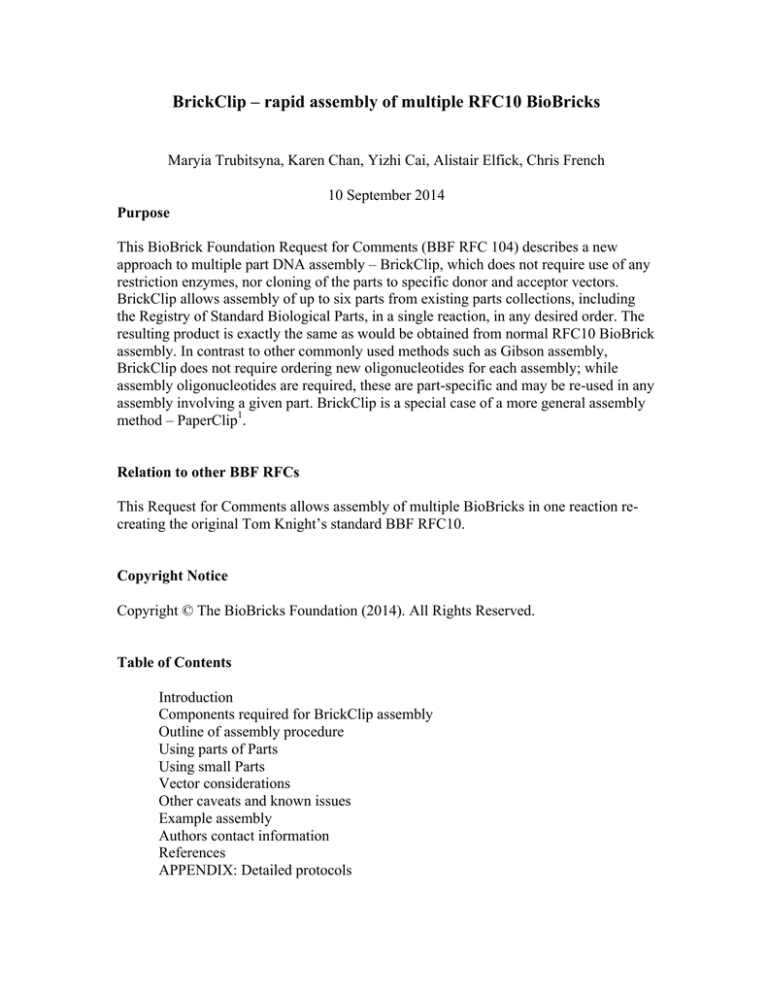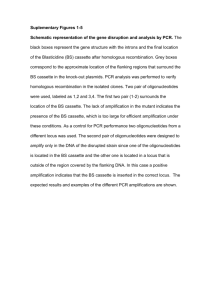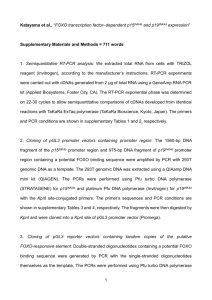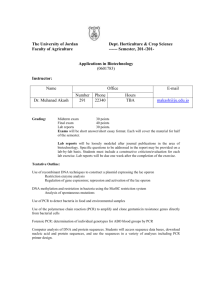BrickClip – rapid assembly of multiple RFC10 BioBricks
advertisement

BrickClip – rapid assembly of multiple RFC10 BioBricks
Maryia Trubitsyna, Karen Chan, Yizhi Cai, Alistair Elfick, Chris French
10 September 2014
Purpose
This BioBrick Foundation Request for Comments (BBF RFC 104) describes a new
approach to multiple part DNA assembly – BrickClip, which does not require use of any
restriction enzymes, nor cloning of the parts to specific donor and acceptor vectors.
BrickClip allows assembly of up to six parts from existing parts collections, including
the Registry of Standard Biological Parts, in a single reaction, in any desired order. The
resulting product is exactly the same as would be obtained from normal RFC10 BioBrick
assembly. In contrast to other commonly used methods such as Gibson assembly,
BrickClip does not require ordering new oligonucleotides for each assembly; while
assembly oligonucleotides are required, these are part-specific and may be re-used in any
assembly involving a given part. BrickClip is a special case of a more general assembly
method – PaperClip1.
Relation to other BBF RFCs
This Request for Comments allows assembly of multiple BioBricks in one reaction recreating the original Tom Knight’s standard BBF RFC10.
Copyright Notice
Copyright © The BioBricks Foundation (2014). All Rights Reserved.
Table of Contents
Introduction
Components required for BrickClip assembly
Outline of assembly procedure
Using parts of Parts
Using small Parts
Vector considerations
Other caveats and known issues
Example assembly
Authors contact information
References
APPENDIX: Detailed protocols
BBF RFC 104
PaperClip standard
Introduction
Assembly of DNA parts into larger systems is an essential procedure in synthetic
biology2, and many methods are available. For example, the iGEM competition is (at the
time of writing) based around the BBF RFC10 'BioBrick' standard proposed by T.
Knight, and a large number of RFC10 BioBricks is available through the Registry of
Standard Biological Parts. Assembly of BioBricks from the Registry using the RFC10
procedure is completely flexible; that is, any parts can be assembled in any order. This
concept has revolutionized synthetic biology. However, RFC10 assembly can be
relatively slow, as it is a hierarchical procedure requiring BioBricks to be assembled
pairwise, usually with cloning and sequence verification required at each step. For this
reason, other procedures such as Gibson assembly3 have become widely used. This
procedure allows rapid multiple part assembly in a single reaction taking one hour, with
the order of the parts being determined by homology regions at the end of each part. The
drawback to this and similar end-homology-based procedures (LIC4, SLIC5, SLICE6,
USER7, CPEC8) is that parts generally need to have end-homology added before
assembly, usually by PCR, requiring specific single-use oligonucleotide primers to be
acquired for each part for each assembly.
An ideal assembly procedure would allow rapid assembly of multiple parts in a single
reaction, while maintaining the flexibility of BioBricks - that is, allowing any parts to be
assembled in any order without the necessity for new oligonucleotides or other
components to be ordered for each assembly. Ideally it should also allow use of preexisting parts libraries without the necessity for re-cloning into specific donor vectors, or
ensuring the absence of specific restrictions sites. We have developed a general
procedure fulfilling these requirements: PaperClip assembly1. In this RFC, we describe a
modified form of PaperClip assembly, BrickClip, which has been specially designed so
that multiple RFC10 BioBricks from the Registry of Standard Biological Parts or any
new Parts can be assembled in a single reaction, giving the same product that would be
obtained from standard pairwise RFC10 assembly.
Components required for BrickClip assembly
BrickClip is an example of an oligonucleotide-directed assembly procedure, in which
multiple Parts are assembled in a single reaction. The order of Parts is directed by
oligonucleotides, which bridge the sequence of adjacent Parts. In contrast to other such
procedures, BrickClip does not require new bridging oligonucleotides to be obtained for
each assembly. Rather, the bridging double-stranded oligonucleotides ('Clips') are
formed by pre-assembly ligation of shorter double-stranded 'half-Clips' corresponding to
the ends of each Part. Thus, each component of a BrickClip library consists of (Figure 1,
a):
•
the Part itself, which may be a linear PCR product, or may be cloned in any
vector. For illustrative purposes, in this RFC, we will assume that all Parts are
RFC10 BioBricks cloned in pSB1C3. For maximum efficiency of assembly, all
Parts should be linearized, by cutting with any restriction enzyme that cuts
2
BBF RFC 104
•
PaperClip standard
outside the Part (e.g., EcoRI, XhoI, SpeI or PstI, in the case of RFC10
BioBricks), though uncut plasmid DNA can also be used with lower efficiency.
four oligonucleotides, each around 40 bases in length: upstream forward (UF),
upstream reverse (UR), downstream forward (DF), and downstream reverse
(DR). These oligonucleotides may be re-used in any assembly involving the Part.
The oligonucleotides are prepared for use by 5'-phosphorylation (using T4
polynucleotide kinase) and then annealing in pairs to form the Upstream halfClip, consisting of oligonucleotides UF and UR, and the Downstream half-Clip,
consisting of oligonucleotides DF and DR. The Upstream half-Clip has a 5'overhang CTA at the outer (upstream) end and a part-specific three base 3'
overhang at the inner (downstream) end (Figure 1, a, A). The Downstream halfClip has 5' overhang TAG at the outer (downstream) end and a part-specific three
base 5' overhang, which can be anything other than CTA or TAG, at the inner
(upstream) end (Figure 1, a, B). Once prepared and annealed, the half-Clips may
be stored with the Part and can be used in any assembly involving that Part.
Thus the overall composition of the four oligonucleotides, in relation to the Part, is as
follows:
UPSTREAM HALF-CLIP (Figure 1, a, A and E)
UF 5'-CTAgagnnnnnnnnnnnnnnnnnnnnnnnnnnnnnnnnnnnnn-3'
UR
3'-ctcnnnnnnnnnnnnnnnnnnnnnnnnnnnnnnnnnn-5'
DOWNSTREAM HALF-CLIP (Figure 1, a, B and F)
DF 5'-xyznnnnnnnnnnnnnnnnnnnnnnnnnnnnnnnnnnnnnta-3'
DR
3'-nnnnnnnnnnnnnnnnnnnnnnnnnnnnnnnnnnnnnatGAT-5'
Note that the bases, shown as 'xyz' must not be CTA or TAG. The three-base overhangs
at the inner ends are present only to prevent these ends from ligating.
The sequence of the Clips for the vector must include Prefix and Suffix:
VECTOR UPSTREAM HALF-CLIP includes Suffix (Figure 1, a, C)
UF 5'-CTAgtagcggccgctgcagnnnnnnnnnnnnnnnnnnnnnnnn-3'
UR
3'-catcgccggcgacgtcnnnnnnnnnnnnnnnnnnnnn-5'
VECTOR DOWNSTREAM HALF-CLIP includes Prefix (Figure 1, a, D)
DF 5'-xyznnnnnnnnnnnnnnnnnnnngaattcgcggccgctt-3'
DR
3'-nnnnnnnnnnnnnnnnnnnncttaagcgccggcgaaGAT-5'
The bases, shown as 'xyz' must not be CTA or TAG.
3
BBF RFC 104
PaperClip standard
Figure 1. Illustrative scheme for Parts library (a), for Clips preparation for three-part
assembly (b) and example of five-part assembly (c).
Outline of assembly procedure
For example, suppose that three parts: 1, 2 (vector) and 3, are to be assembled to make a
circular construct 1-2-3 (Figure 1, b). The procedure is as follows:
1 – perform the following ligations (one hour):
• Part 1-Downstream half-Clip (B) + Part 2-Upstream half-Clip (C)
• Part 2-Downstream half-Clip (D) + Part 3-Upstream half-Clip (E)
4
BBF RFC 104
•
PaperClip standard
Part 3-Downstream half-Clip (F) + Part 1-Upstream half-Clip (A)
2 – mix the three ligations (no purification required) with the three (preferably linear)
Parts to be assembled, and perform a standard PCR reaction (requires approximately one
hour depending on the size of the final construct).
3 – transform competent cells with the PCR product (no purification required).
On the other hand, if the parts were to be assembled in the order 1-3-2, it would simply
be necessary to do different ligations, as follows:
• Part 1-Downstream half-Clip (B) + Part 3-Upstream half-Clip (E)
• Part 3-Downstream half-Clip (F) + Part 2-Upstream half-Clip (C)
• Part 2-Downstream half-Clip (D) + Part 1-Upstream half-Clip (A)
Using parts of Parts
It should be noted that the actual sequence of the BioBrick Part, which is incorporated
into the assembly is determined by the Clip sequences used. Thus, if you have a
BioBrick Part from the Registry but do not want to include the entire Part in your
assembly, you can just design your Clip oligonucleotides to include the region you want,
and exclude unwanted regions at one or both ends. This is particularly useful for
constructing fusion proteins, or to add N- or C-terminal tags to proteins, as it is possible
to use a coding sequence Part from the Registry, but design the Clip oligonucleotides to
leave out the start and/or stop codon. Clips can also add a few extra bases at the start or
end of the part simply by including these at the outer ends of the Clip oligonucleotides.
To add larger elements, see 'Using Small Parts' below.
Using 'Small Parts'
It should be noted that this procedure will only be effective for parts around 60 bases in
length. Smaller parts, such as ribosome binding sites, can conveniently be added in the
form of oligonucleotides included in the Clip ligation reactions (as described above).
Small Part should be prepared in the form of four oligonucleotides as shown below:
UF 5'-CTAgagnnn...nnnn
-3'
UR 3'ctcnnn...nnnnvwxyz-5'
DF 5'-hijklnnn...nnnnnta
-3'
DR 3'nnn...nnnnnatGAT-5'
Note that the bases shown as 'hijkl' should be complementary to those shown as 'vwxyz'.
These oligonucleotides should, again, be phosphorylated and annealed in pairs to form
an Upstream half-Part and a Downstream half-Part, exactly as for half-Clips.
In this case the Clip Ligation for each assembly should be performed in two stages
(Figure 2). First – the Downstream half-Clip of the Part 1 should be ligated to the
Upstream half-Part of the small Part (X). Second – the Downstream half-Part of the
small Part should be ligated to the Upstream half-Clip of the Part 2 (Figure 2, a). Then
the products of these two reactions can be ligated together (by placing these two ligation
5
BBF RFC 104
PaperClip standard
reactions in one tube) to form the final Clip (1+X+2) to be used in the assembly (Figure
2, b).
This procedure can also be used to add N- or C-terminal tags to a coding sequence part
which does not include the start or stop codon (these can simply be left out of the Clip
oligonucleotides as described above) or a fusion peptide linker; however, in this case the
ends must be modified so as not to include an in-frame stop codon. This is quite
straightforward, but a detailed description of the design considerations is beyond the
scope of this RFC.
Figure 2. Scheme for addition of desired sequence (in red) between the Parts 1 and 2.
Vector considerations
The majority of Parts in the Registry are cloned in pSB1C3. If the final construct is in
pSB1C3 vector as well, recovery of background Parts can be greatly decreased by
initially performing PCR using the Part plasmid as a template (< 1 ng), and
oligonucleotides UF and DR as primers. The resulting PCR product is then treated with
DpnI restriction enzyme to remove residual template DNA, and can then be used as a
Part in the assembly.
Alternatively, to avoid recovering Parts after the assembly reaction, it may be
advantageous to perform your assembly initially in a different vector such as pSB1K3,
using the RFP-tagged version of the vector as a Part (assuming that your assembly does
not contain RFP). In this case, all non-red kanamycin-resistant colonies should be the
correct product. For submission to the Registry, you can then perform a simple vector
swap using, e.g., EcoRI and PstI to transfer the construct back to pSB1C3.
Other caveats and known issues
If assembling by the PCR method described in this RFC, Parts may not contain
substantial repetitive sequences (i.e., with Tm above 65˚C), and must not contain
substantial sequences (>20 bp, Tm above 65oC), which are also present in other parts in
the same assembly. If this is the case, deletion between the repeats is likely to occur
6
BBF RFC 104
PaperClip standard
during the amplification procedure. For example, we recommend against using the same
RBS in more than one place in a single construct. Such constructs are quite likely to be
unstable in vivo in any case.
Example assembly
We have successfully performed three-part assembly (Figure 1, a and b) of BioBricks –
pSB1C3 vector, Plac-lacZ’ (BBa_J33207) and KanR (from pSB1K3) and sequence
verified the presence of the characteristic Prefix, Scars and Suffix. Using the general
PaperClip assembly up to six parts are assembled (example in Figure 1, c) raising more
than 1000 resistant colonies (competent cells are CFU=3*107/µg pUC19), with less than
1% error rate as judged by colony phenotype.
Authors contact information
Maryia Trubitsyna (m.trubitsyna@ed.ac.uk)
Karen Chan (karenchan1@gmail.com )
Yizhi Cai (yizhi.cai@ed.ac.uk)
Alistair Elfick (alistair.elfick@ed.ac.uk)
Chris French (c.french@ed.ac.uk)
References
1
2
3
4
5
6
7
8
Trubitsyna, M., Michlewski, G., Cai, Y., Elfick, A. & French, C. E.
PaperClip: rapid multi-part DNA assembly from existing libraries. Nucleic
Acids Research, doi:10.1093/nar/gku829 (2014).
Ellis, T., Adie, T. & Baldwin, G. S. DNA assembly for synthetic biology: from
parts to pathways and beyond. Integrative biology : quantitative biosciences
from nano to macro 3, 109-118, doi:10.1039/c0ib00070a (2011).
Gibson, D. G. et al. Enzymatic assembly of DNA molecules up to several
hundred kilobases. Nat Methods 6, 343-345, doi:10.1038/nmeth.1318 (2009).
Yang, J., Zhang, Z., Zhang, X. A. & Luo, Q. A ligation-independent cloning
method using nicking DNA endonuclease. Biotechniques 49, 817-821,
doi:10.2144/000113520 (2010).
Li, M. Z. & Elledge, S. J. SLIC: a method for sequence- and ligationindependent cloning. Methods Mol Biol 852, 51-59, doi:10.1007/978-1-61779564-0_5 (2012).
Zhang, Y., Werling, U. & Edelmann, W. SLiCE: a novel bacterial cell
extract-based DNA cloning method. Nucleic Acids Res 40, e55,
doi:10.1093/nar/gkr1288 (2012).
Annaluru, N. et al. Assembling DNA fragments by USER fusion. Methods
Mol Biol 852, 77-95, doi:10.1007/978-1-61779-564-0_7 (2012).
Quan, J. & Tian, J. Circular polymerase extension cloning of complex gene
libraries and pathways. PloS one 4, e6441, doi:10.1371/journal.pone.0006441
(2009).
7
BBF RFC 104
PaperClip standard
APPENDIX: Detailed protocols
1. Algorithm for design of Clip oligonucleotides
1. Obtain the sequence of the Part. For RFC10 BioBricks this is the sequence as shown
in the Registry, i.e. without the RFC10 Prefix or Suffix.
2. Take the first 37 bases of the Part sequence and add CTAGAG at the start – this is
Upstream Forward (UF).
3. Take the reverse complement of the first 34 bases of the Part sequence, and add CTC
at the end – this is Upstream Reverse (UR).
4. Take the last 37 bases of the Part sequence. If the first three bases are not TAG or
CTA, then add TA at the end. This is Downstream Forward (DF). On the other hand, if
the first three bases are either TAG or CTA, then remove one base from the start of the
sequence, and again check that the first three bases are not TAG or CTA, before adding
TA at the end and proceeding.
5. Take the reverse complement of UF, add TAG at the start, and delete the last three
bases. This is downstream reverse (DF).
6. Using a melting temperature calculator such as that on the IDT system at:
https://eu.idtdna.com/analyzer/Applications/OligoAnalyzer/
check that the Tm of each oligonucleotide is between 55˚C and 75˚C. If not, repeat the
procedure starting with a shorter or longer base length (e.g., 32 or 42 bases rather than 37
bases). Check that the final oligonucleotides, when annealed, will give the correct
overhangs as shown below:
UPSTREAM HALF-CLIP
UF 5'-CTAgagnnnnnnnnnnnnnnnnnnnnnnnnnnnnnnnnnnnnn-3'
UR
3'-ctcnnnnnnnnnnnnnnnnnnnnnnnnnnnnnnnnnn-5'
DOWNSTREAM HALF-CLIP
DF 5'-xyznnnnnnnnnnnnnnnnnnnnnnnnnnnnnnnnnnnnnta-3'
DR
3'-nnnnnnnnnnnnnnnnnnnnnnnnnnnnnnnnnnnnnatGAT-5'
Note that the bases, shown as 'xyz' must not be CTA or TAG. The three-base overhangs
at the inner ends are present only to prevent these ends from ligating.
7. It is recommended that the oligonucleotides should be named as BC_[PartName]_UF,
BC_[PartName]_UR, etc.
8
BBF RFC 104
PaperClip standard
8. EXCEPTION: Preparation of Clips for Vector Parts
In the cases of vector Parts, if it is desired that the product should be identical to that
formed by normal RFC10 assembly, the Clips must be designed to include the Prefix and
Suffix, as shown below:
VECTOR UPSTREAM HALF-CLIP
UF 5'-CTAgtagcggccgctgcagnnnnnnnnnnnnnnnnnnnnnnnn-3'
UR
3'-cttcgccggcgacgtcnnnnnnnnnnnnnnnnnnnnn-5'
VECTOR DOWNSTREAM HALF-CLIP
DF 5'-xyznnnnnnnnnnnnnnnnnnnngaattcgcggccgctt-3'
DR
3'-nnnnnnnnnnnnnnnnnnnncttaagcgccggcgaaGAT-5'
Again, the bases, shown as 'xyz' must not be CTA or TAG.
2. Preparation of half-Clips
1. Dissolve oligonucleotides at 100 µM in nuclease-free water.
2. Set up phosphorylation reactions for oligonucleotide pairs UF+UR and DF+DR as
follows:
5 µl
0.5 µl
5 µl
20 µl
20 µl
10xT4 PNK buffer (NEB or Thermo Fisher Scientific)
T4 PNK (NEB or Thermo Fisher Scientific)
10 mM ATP (final 1 mM)
oligo 1 (100 µM) (final 40 µM)
oligo 2 (100 µM) (final 40 µM)
3. Incubate 30 min at 37oC
4. Add 5µl 5M NaCl (final 500 mM)
5. Place the tubes into a boiling waterbath, and allow to slowly cool down to room
temperature (~25oC), then place on ice. Alternatively put the tubes in a PCR machine
using a temperature program to cool from 95oC to 4oC at 0.1oC/sec (takes about 20 min).
6. Store the half-Clips at -20oC. For use, defrost them on ice, keep on ice while using.
3a. Preparation of Parts by PCR
If the Parts are not already available as cloned BioBricks in pSB1C3, they can be
amplified from a suitable template (e.g., genomic DNA) using oligonucleotides UF and
DR as primers, using any standard PCR protocol with a suitable proof-reading DNA
9
BBF RFC 104
PaperClip standard
polymerase such as KOD (Merck-Novagen) or Phusion (NEB), according to the
manufacturer's protocol. Even if Parts are already cloned, it may be advantageous in
some cases to prepare Parts as PCR products prior to assembly in order to reduce the
likelihood of recovering non-assembled Parts in the transformed colonies, depending on
the Parts and selection used (see 'Vector considerations' in main text).
Following PCR, add 1 µl of DpnI restriction enzyme (NEB) to the PCR reaction to get
rid of the template DNA. Incubate for 1 hour at 37oC. The PCR product should be
checked by agarose gel electrophoresis and purified from the reaction mixture using any
standard method (e.g., QIAquick PCR purification Kit). If more than one band is
observed after the PCR, gel-purification should be performed.
3b. Use of linearized plasmids as Parts
If the parts are within a vector backbone such as pSB1C3 and the DNA concentration is
high enough, linearize the plasmid with any restriction enzyme, which doesn’t cut in the
part, or cut out the insert. (Be careful about the selection markers, so that you do not
recover your starting plasmid). Use1 µg of plasmid in 50 µl volume, incubate for 1 hour
at appropriate temperature (usually +37oC), followed by heat inactivation at a
temperature appropriate for the enzyme used (see manufacturer's information).
4. Preparation of Clips for each assembly:
1. Prepare ligation reactions as follows:
4 µl
4 µl
1 µl
1 µl
0.5 µl
Downstream half-Clip (already phosphorylated and annealed)
Upstream half-Clip (already phosphorylated and annealed)
10xLigase buffer (NEB or Thermo Fisher Scientific)
10 mM ATP
T4 ligase (NEB or Thermo Fisher Scientific)
2. Incubate for 1 hour at +16oC or overnight.
3. Inactivate ligase for 10 min at 65oC. Spin down, keep on ice, store at -20oC, defrost on
ice, keep on ice.
NOTE: if using Small Parts in the form of oligonucleotides, it will be necessary to do
two sequential ligations as described in the main text under 'Using Small Parts'. Briefly:
first set up two ligations as described above, one with the Downstream half-Clip of the
upstream part and the Upstream half-Part of the Small Part; second, with the
Downstream half-Part of the Small Part and the Upstream half-Clip of the downstream
part. Incubate these for one hour as indicated, then mix the two reactions together and
continue the incubation.
Keep the Clips and Parts at -20oC well labelled, as they only need to be prepared once
and will be used again in future assemblies.
10
BBF RFC 104
PaperClip standard
5. Checking ligation efficiency by PAGE or agarose gel-electrophoresis (optional)
Efficiency of the ligation may be tested by analysing a sample of the ligation mixture on
a 12% polyacrylamide gel made in 0.5xTBE buffer, and staining with a suitable DNA
stain such as GelGreen™ Nucleic Acid Gel Stain in water (BIOTIUM Inc.) or SafeWhite
loading buffer (NBS Biologicals).
6. Assembly reaction using PCR:
1. Prepare the assembly reaction as follows:
x µl
5 µl
5 µl
3 µl
200 ng
100 ng
100 ng
0.21 µl
0.21 µl
0.21 µl
1 µl
nuclease free water (to make total volume 50 µl)
10xPCR buffer for KOD Hot start DNA polymerase (Merck-Novagen)
dNTPs (2 mM, final 0.2 mM)
MgSO4 (25 mM, final 1.5 mM)
pSB1C3 backbone
part 2
part 3 and up to 6 parts works perfect
Clip1 (pSB1C3Down/part2Up)
Clip2 (part2Down/part3Up)
Clip3 (part3Down/… and so on)
KOD Hot Start DNA polymerase (Merck-Novagen)
2. Perform two-step PCR as follows:
95oC 2 min
20 cycles:
95oC 20 sec
70oC (10 sec/kb for <500 bp, 15 sec/kb for 500-1000 bp, 20 sec/kb, 1000-3000 bp, 25
sec/kb for >3000 bp total construct size).
4oC
hold
7. Booster PCR reaction (optional, improves efficiency for higher numbers of parts;
recommended for assemblies with 6 or more parts)
1. Prepare the booster PCR reaction as follows:
x µl
5 µl
5 µl
5 µl
3 µl
1 µl
nuclease free water (to make total volume 50 µl)
of the first PCR reaction
10xPCR buffer for KOD Hot start DNA polymerase (Merck-Novagen)
dNTPs (2 mM, final 0.2 mM)
MgSO4 (25 mM, final 1.5 mM)
KOD Hot Start DNA polymerase (Merck-Novagen)
11
BBF RFC 104
PaperClip standard
2. Perform PCR using the same program as shown above.
8. Transformation
Transform 100 µl of chemically competent cells with 5 µl of the assembly reaction (or 1
µl if the assembly only involves two parts). Any standard transformation protocol may
be used. For chemically competent cells, plating 100 µl (1/5th) of transformation mixture
(or 200 µl for 5 or 6 part assembly), expect to see 100-2000 colonies.
12







